MileValue is part of an affiliate sales network and receives compensation for sending traffic to partner sites, such as CreditCards.com. This site may earn compensation when a customer clicks on a link, when an application is approved, or when an account is opened. This compensation may impact how and where links appear on this site. This site does not include all financial companies or all available financial offers. Terms apply to American Express benefits and offers. Enrollment may be required for select American Express benefits and offers. Visit americanexpress.com to learn more. All values of Membership Rewards are assigned based on the assumption, experience and opinions of the 10xTravel team and represent an estimate and not an actual value of points. Estimated value is not a fixed value and may not be the typical value enjoyed by card members.
If you don’t know what an open-jaw itinerary is and haven’t booked flights this way, you’re not alone.
The simplest way to think about an open jaw is that it represents a gap without flights at some point in an itinerary. A common use is for two-way travel on an itinerary where the destination and/or the origin cities aren’t the same in both directions.
An example of an open-jaw itinerary with flights from Chicago (ORD) to Paris (CDG) and Madrid (MAD) to Chicago is depicted below. The open-jaw segment—which isn’t covered by flights—is between Paris and Madrid.
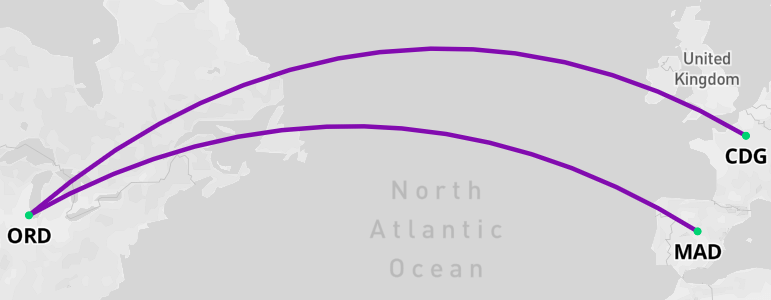
Itineraries with open jaws and double open jaws—the latter have two open-jaw segments—can be valuable options in some situations.
Key Terminology
Let’s begin with some terms related to booking flights with points and miles or cash.
Outbound and Inbound Flights
When talking about flights in two different directions, the terms outbound and inbound often are used.
- Outbound: The flight (or series of connecting flights) at the beginning of a trip is referred to as outbound travel. There can be one flight from the first airport (also known as the origin) to the destination airport, or there can be one or more connecting flights to the destination.
- Inbound: The flight(s) in the other direction are referred to as inbound travel. There can be one nonstop flight or two or more connecting flights comprising inbound travel.
Here’s an example. Someone may choose to book flights from Pittsburgh to Los Angeles and back for vacation. The outbound direction involves two flights: Pittsburgh to Chicago and Chicago to Los Angeles. The inbound direction has three flights: Los Angeles to Denver, Denver to Chicago, and Chicago to Pittsburgh.
Sometimes, you’ll see the term “return” used to refer to the inbound flight, but this description can be confusing because it has a second meaning. Outside the United States, “return” often is used to refer to round-trip flights.
Nonstop, Direct and Connecting Flights
While the terms “nonstop flight” and “direct flight” sometimes are used interchangeably, they aren’t the same. Nonstop flights start at airport A and end at airport B without landing anywhere between A and B. Direct flights include nonstop flights as well as routes with a single flight number that stop at airport C between airport A and airport B. The latter can occur with a refuel stop, also known as a technical stop, but these flights are rare.
Besides having the same flight number for both flights, one or more of the following conditions may apply to direct flights with an enroute stop:
- The same plane may be used for the two flights.
- Through-passengers may not deplane during the stop.
- New passengers may board, and passengers may end travel at a stop on a direct flight.
- A plane may refuel at a stop on a direct flight.
Connecting flights have one or more layovers, and each flight has a different flight number. In most instances, passengers on connecting flights land at one gate, deplane and go to another gate for the connecting flight.

Round-Trip, One-Way and Multi-City Booking Options
There are three basic booking options on most airline booking sites.
Round-Trip Booking
Many travelers don’t consider options besides booking round-trip flights. This focus is understandable because:
- It’s common for airlines to market flights by showing round-trip prices.
- In the past, booking round-trip tickets has been the least expensive option.
- Many people plan trips involving travel from home to a single destination and back home.
Round-trip itineraries involve booking a flight from an origin airport to a destination airport and back (there can be connecting flights in either or both directions) to the origin airport on a single ticket. In generic terms, the routing for a nonstop round-trip itinerary is airport A to airport B to airport A.
Booking flights on a single ticket means that there is one confirmation number (also referred to as a record locator or a passenger name record) that encompasses the entire trip and one ticket number for travel in both directions.
Round-trip flights often involve travel on a single airline, but they can involve different operating carriers as long as flights are booked on a single ticket. For example, it’s possible to book a round-trip itinerary between the United States and Germany using United MileagePlus miles with the outbound flight operated by United Airlines and connecting or inbound flights operated by Lufthansa, a United partner.
For any booking option (round-trip, one-way or multi-city) with some or all flights operated by a different airline than the booking (also referred to as marketing) carrier that are booked on a single ticket:
- There may be additional confirmation numbers for flights on partner carriers. In the example of a United award booking with flights operated by United and Lufthansa, there would be one confirmation number that’s used for flight(s) operated by United and a different confirmation number used for flight(s) operated by Lufthansa.
- There can be differences in options available for booking flights on multiple airlines within a single ticket for award tickets and cash tickets.
One-Way Booking
Individuals with more experience booking flights with points and miles may consider other booking approaches, such as booking separate one-way flights for travel on different parts of a trip. Separate bookings often enable travelers to use points and miles more effectively by piecing together trips with flights on multiple airlines and using points and miles with different programs.
If a traveler books an itinerary from one airport to another and back to the origin airport as two separate one-way tickets instead of one round-trip ticket, each one-way itinerary has a unique confirmation number and a unique ticket number. This is true even if all flights are on the same airline.
The most significant practical difference between booking flights as two one-way tickets vs. one round-trip ticket, is that with two one-way tickets, the inbound flight (from A to B) and the outbound flight (from B to A) are completely independent from each other. We’ll discuss the implications of that and some pros and cons of booking round-trip tickets vs. booking two one-way tickets later.
Multi-City Booking
The third option available on most airline and third-party booking sites usually is called multi-city. Booking flights through multi-city functionality may be useful for building more complex itineraries that include long layovers, stopovers and/or open jaws.
Functionality varies by booking tool. Some multi-city booking tools can be used to book flights that are considered open-jaw itineraries. Some multi-city tools allow you to book connecting itineraries with layovers or stopovers that aren’t possible with one-way or round-trip booking options. When booking via multi-city functionality, all flights in the itinerary will be on a single ticket and have one overall confirmation number.
Layovers and Stopovers
These terms are used in conjunction with connecting flights. For example, if you’re flying from a smaller airport in the U.S., your routing typically requires connecting flights. Layovers and stopovers refer to time at the connecting airport.
The primary difference between layovers and stopovers is the amount of time between the two flights. A connection time exceeding 23 hours 59 minutes generally is considered a stopover. Layovers are shorter, but airline-specific rules often don’t allow booking long layovers. Routes entirely within the U.S. often have shorter connecting time limits and additional restrictions.
Some airlines don’t allow stopovers on a single ticket, but there’s a way for travelers who want to spend more time in a connecting city to achieve this objective. Essentially, you can simulate a stopover by booking two one-way flights on separate tickets with the desired amount of time between flights.
Although layovers and stopovers aren’t the same as open-jaw flights, we’re discussing the three concepts together because of potential for confusion since multi-city booking functionality may be used for booking long layovers, stopovers and routes with open jaws.
For example, Alaska Airlines allows booking stopovers and open jaws through its multi-city booking option.
Using Multi-City Search to Book a Stopover
First, let’s consider an Alaska itinerary with a stopover. A traveler who wants to visit San Francisco (SFO) and Seattle (SEA) on the same trip and fly between the two airports might book this. In this example, the search criteria specifies flights from Washington (IAD) to Seattle on Feb. 3 and Seattle to San Francisco two days later. Although this itinerary includes travel in one direction, the search utilizes the multi-city option instead of the one-way option to include a stopover.

The selected flights are shown below, and the award rate is the same as booking the same itinerary with a standard layover in Seattle. In some situations, taxes increase. For domestic routes booked through U.S. airline programs, taxes and fees are $5.60 for connections shorter than four hours or $11.20 for longer connections.

Using Multi-City Search to Book an Open-Jaw Route
This example is of an open-jaw routing on a single ticket. You might want to use this option if you plan to use another mode of transportation between the destination for the outbound flight and the origin for the inbound flight.
Search criteria using the multi-city option are shown below.

This itinerary includes travel in both directions between Washington (IAD) and two cities in California. The outbound flight is to San Diego (SAN). Travel between San Diego and Los Angeles isn’t covered by flights on this itinerary. Inbound flights are from Los Angeles to Washington with a standard connection in Seattle. If desired, you could include a longer layover or stopover in Seattle for the same award rate.
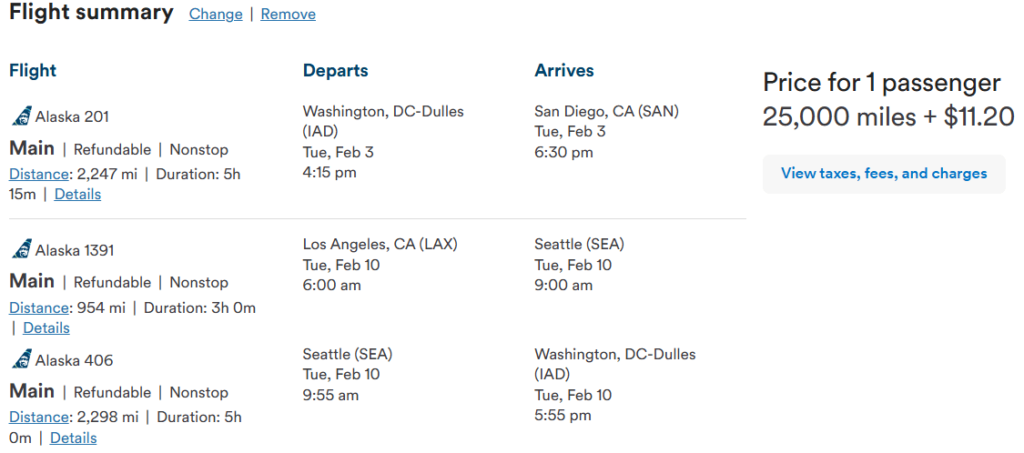
Open Jaws and Double Open Jaws
Let’s take a closer look at the example displayed at the beginning of the article for an open-jaw route. This route might work for travelers who live in Chicago and are going to Europe for vacation and want to visit more than one city. The desired itinerary includes:
- A nonstop flight from Chicago (ORD)—let’s refer to this generically as airport A—to Paris (CDG) / airport B
- Travel by train, bus, car and/or boat within Europe
- A nonstop flight from Madrid (MAD) / airport C to Chicago / airport A

This open-jaw route is characterized by the following elements:
- The origin for the outbound flight (Chicago) is the same as the destination for the inbound flight.
- The destination for the outbound flight (Paris) is different from the origin for the inbound flight (Madrid).
- There is a gap without flights (between Paris and Madrid) which is an open jaw. In this case, the open jaw is after the inbound destination, but it’s also possible to have an open jaw between the inbound flight origin and the outbound flight destination.
Using generic letters to represent airports, an open-jaw route is different from a round-trip route. The open-jaw path is A to B (outbound) and C to A (inbound). The round-trip routing is A to B (outbound) and B to A (inbound).
To illustrate the concept of a double open jaw, let’s change one element of the open-jaw itinerary above. In this case, airports A, B and C remain the same, but instead of returning to airport A, the destination for the inbound flight is a different airport, say New York (JFK) or airport D.
A traveler may find a route like this useful if attending an event in New York the day after the flight back from Europe. Flights are from Chicago to Paris and Madrid to New York. There are two open jaws—between Paris and Madrid and Chicago and New York—as depicted here.
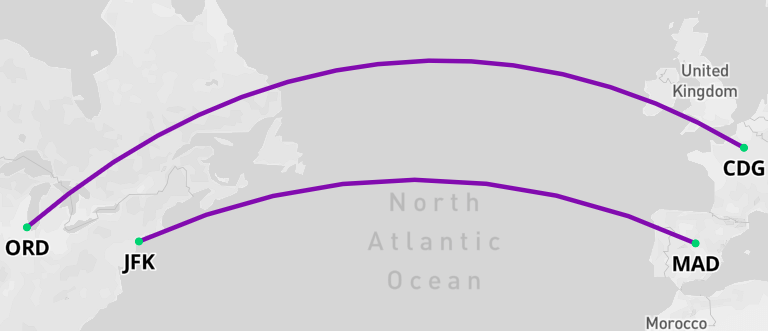
Using letters to represent airports, the double open-jaw route is A to B (outbound) and C to D (inbound). The open jaws not covered by flights on this itinerary are between cities B and C in Europe and cities D and A in the U.S.
Open Jaws on One Ticket vs. Separate One-Way Tickets
Although the term open jaw typically isn’t used to discuss flights booked as separate one-way tickets, booking multiple one-way tickets is a common booking technique, particularly when redeeming points and miles. If you book A to B as a one-way ticket, and C to A as a second one-way ticket, the resulting itinerary is the same as booking an open jaw from A to B and C to A on a single ticket. This principle also applies to booking routes with two open jaws.
There are valid reasons for both booking approaches, so the decision depends on personal preferences and the specific situation.
Reasons to Book an Open-Jaw Itinerary on One Ticket
Some of the reasons are strategic, while others are more pragmatic. You may want to consider booking flights on one ticket in the following situations.
Desire to Limit Change or Cancellation Fees and Ensure that the Trip is Considered a Single Entity
For travelers who are uncertain about plans, limiting potential change or cancellation fees is a common driver for booking round-trip or open-jaw flights on the same ticket. Most U.S.-based airline loyalty programs don’t have change or cancellation fees on award tickets, but many foreign programs do.
Beyond traveler-initiated changes or cancellations, there can be involuntary changes to one flight that impact plans for later flights on the same trip. If an airline cancels an outbound flight and isn’t able to accommodate travelers on another flight in a timely manner, the involuntary change may have significant downstream impacts. Scenarios for involuntary changes with different booking options are:
- Separate tickets: If later flights on the trip are booked on separate tickets and no longer work based on the involuntary change, travelers usually are responsible for change and cancellation fees for downstream flights booked on separate tickets.
- Single ticket: If there are significant changes with an outbound flight when outbound and inbound flights are booked on the same ticket, passengers can cancel the entire trip without fees. Passengers likely also would have more flexibility about changing the inbound itinerary to accommodate changes in outbound travel.
Free Flight with Single Ticket Booking
A well-known example of this is United Airlines’ Excursionist Perk, which, unfortunately, won’t be offered after Aug. 20, 2025. As an example of how this works, travelers interested in booking award flights through the MileagePlus program for travel from the U.S. to one city in Europe and back from another city in Europe can use the Excursionist Perk on a multi-city itinerary to travel between two cities in Europe for zero additional miles (taxes apply). More details and an example are provided below.
Lower Cash or Award Rates for Booking Both Directions on a Single Ticket
Whether rates are the same or different for one ticket or separate one-way tickets is situational. Some points to keep in mind are:
- Depending on the airline and booking tools, lower rates for booking on a single ticket might be available for standard round-trip routes but not for trips with open jaws.
- Discounts for booking outbound and inbound flights on a single ticket usually don’t apply when booking award tickets. There may be situations where booking two separate one-way flights require more points and miles and/or have higher fees compared to booking the same flights on a single ticket. Among U.S. airline programs, Delta SkyMiles occasionally has lower rates for booking outbound and inbound flights on one ticket compared to booking separate one-way awards.
- It’s more common to see lower prices for booking outbound and inbound flights on a single ticket for cash rates on international flights.
Airline Program Limitations on One-Way Awards
For many years, Japanese carrier All Nippon Airlines (ANA) required booking international awards as round-trip or multi-city trips, but this restriction was eliminated for bookings beginning June 24, 2025.
Following ANA’s change, this limitation isn’t applicable for award travel through major airline loyalty programs that most points and miles enthusiasts use. If you encounter a restriction on one-way awards with a lesser-used program, it’s worth checking to see if you can book open-jaw itineraries through multi-city functionality.
Specific Multi-Segment Trips Where All Flights Must Be on a Single Ticket
One situation that often requires having all flights on a single ticket is a round-the-world (RTW) itinerary or similar multi-carrier and multi-flight itineraries. It’s useful to understand how open jaws are defined and handled in routing rules for these complex itineraries.
An open-jaw segment in a RTW or similar routing is a location gap between two flights in the itinerary. This gap is filled by traveling using another mode of transportation or booking a flight on another airline outside of the RTW ticket.
Rates for round-the-world awards typically are determined by total distance. Some programs include the distance of an open-jaw segment when calculating the total distance while others may not include the distance.
In addition, these awards may have limits on the number of travel segments. Individual flights each count as a segment. Differences exist in whether routing rules count open jaws as segments or not (more on this later).
Reasons to Book Two Separate One-Way Tickets
Some of the reasons noted above to book flights on a single ticket also can be reasons to book separate tickets. That’s because of program and situational differences and personal preferences.
Desire for Flexibility to Cancel or Change Flights in One Direction Without Changing the Other Direction
This is a common reason for booking separate tickets. It’s often useful for travelers with more fluid plans as well as for points and miles enthusiasts who may seek opportunities to improve an award booking on one part of the trip while keeping other flights intact.
Lower Cash or Award Rates for Booking Each Direction Separately
It’s unusual to see lower rates for booking the exact same outbound and inbound flights separately compared to booking them as open-jaw flights on a single ticket, but it can happen. In particular, there are a few cases where taxes and fees have been reported to be lower through some foreign airline programs when booking flights in each direction on separate tickets.
Booking Flights at the End of the Schedule or Close to Travel Dates
Some points and miles enthusiasts seeking highly coveted award flights may try to book the flight as soon as the booking window opens, typically 330 to 362 days before travel. If you’re planning a one-week trip and want to book the outbound flight when the airline’s schedule first opens for that flight, you won’t be able to book the inbound ticket at the same time.
On the other end of the spectrum, some travelers seek opportunities to book awards released within 14 days (or fewer) before travel. Travelers seeking close-in awards may need to book outbound and inbound travel separately to access newly available last-minute award space for each flight at different times.
Flights on Multiple Airlines That Can’t Be Booked on One Ticket
If you’re booking directly through an airline’s website, booking options are limited to flights operated by that airline and some partner airline flights. If you’re seeking flights on two different airlines (for example American Airlines on the outbound and Delta Air Lines on the inbound) using airline program miles, the only option is to book these flights on separate tickets.
Open-Jaw Routes That Can’t Be Booked on One Ticket
This situation likely results from airline information technology limitations. Round-trip bookings require using the same origin and destination points, and some booking platforms may not have a multi-city booking option, or the multi-city option might have limitations. Multi-city searches may not work for award flights or the tool might be designed to allow booking flights with stopovers but not open jaws.
For example, Emirates disables the multi-city option when searching for awards on partner airlines.
Open Jaws in Award Examples
Let’s take a look at potential uses of open jaws for booking specific flights to provide more details about some of the ideas discussed above.
United Airlines Excursionist Perk
United’s Excursionist Perk provides a free (no additional miles, but there are increased taxes) one-way flight on some award bookings. Details about this award are provided on United’s website, but United is ending the Excursionist Perk for bookings made (or changes to existing Excursionist Perk bookings) beginning Aug. 21, 2025. The key benefit of the Excursionist Perk is for eligible routes with three distinct flight segments, the middle flight requires zero miles.
To book a route with a free Excursionist Perk flight, MileagePlus members use the multi-city award search. For flights with limited award options, this two-step search approach might be easier:
- Start by checking award availability and rates for each segment separately using the one-way search functionality.
- After finding dates with award availability for each segment, switch to the multi-city search and enter the desired flights and dates.
For this example, let’s look at a trip to Europe with three segments—Chicago to Paris, Paris to Frankfurt, Germany, and Frankfurt to Chicago.
The search criteria below is for an open-jaw route with outbound travel from Chicago to Paris, and inbound travel from Frankfurt to Chicago. You don’t need to search for the route without the middle flight, but we’re showing it to allow comparison of rates with and without the Excursionist Perk flight.
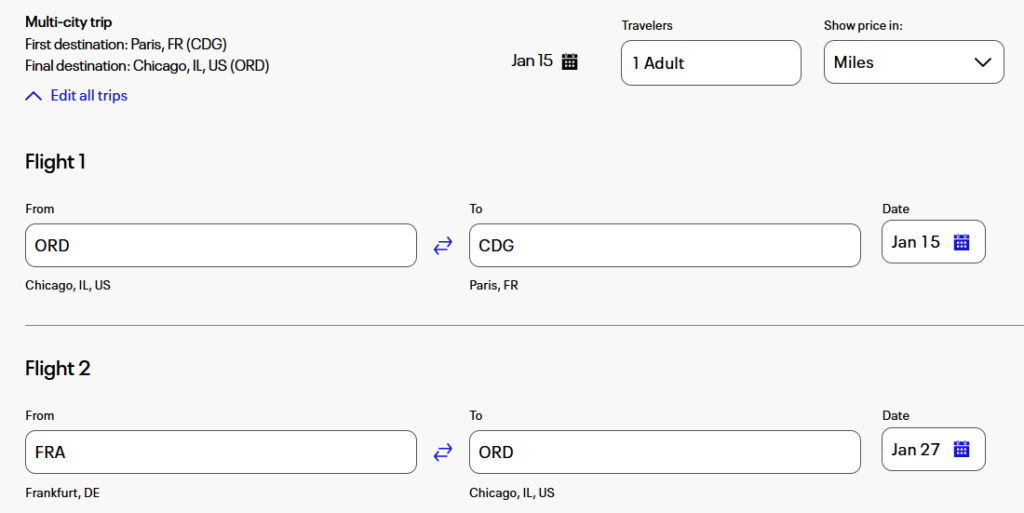
We selected an economy award between Chicago and Paris on Jan. 15 for 36,800 miles plus $5.60 and an economy award between Frankfurt and Chicago on Jan. 27 for 33,100 miles plus $159.41. The total for the open-jaw itinerary is 69,900 miles and $165.01 as shown below.
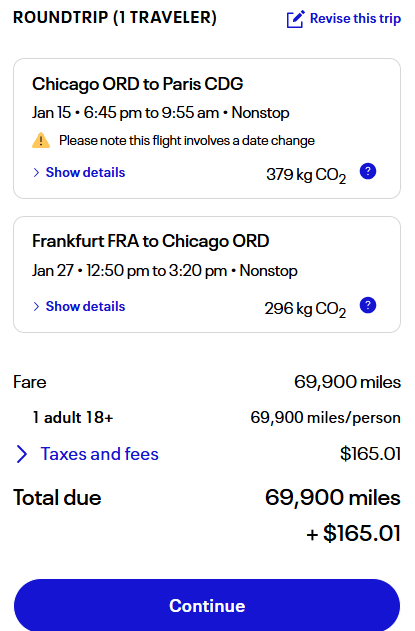
The modified search criteria below include the Excursionist Perk flight between Paris and Frankfurt on Jan. 21.
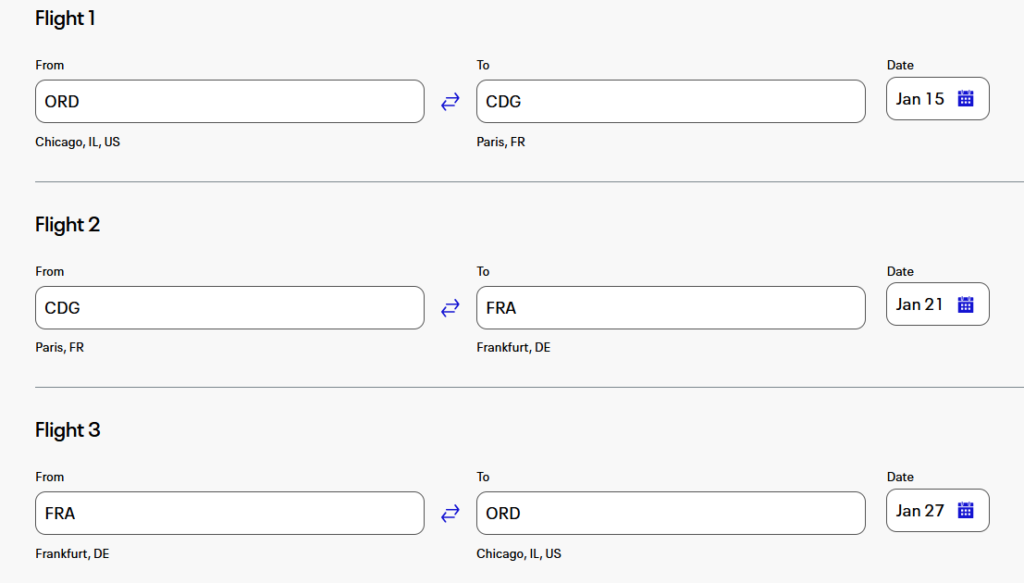
When selecting flight options, all available Lufthansa economy flights showed a cost of zero miles. Taxes and fees for the selected flight are $44.30.
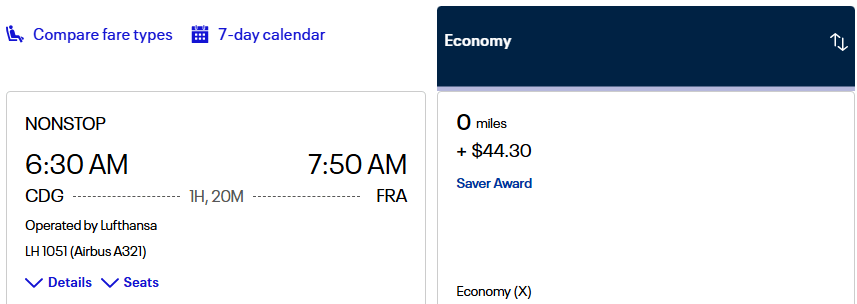
Compared to the initial two-segment itinerary with an open jaw between Paris and Frankfurt, the three-segment itinerary—which includes the Excursionist Perk flight between Paris and Frankfurt— requires the same number of miles and increased taxes as shown below.
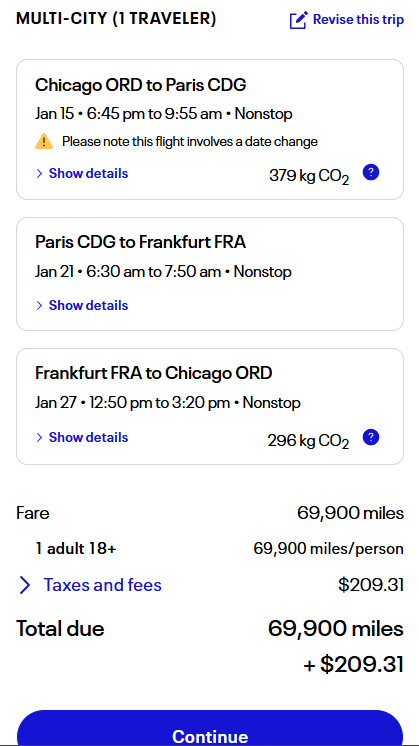
Qantas Oneworld Classic Flight Rewards
With the elimination of popular round-the-world booking options, including Singapore RTW awards in May 2024 and ANA RTW awards in June 2025, one of the more useful current options may be Qantas Frequent Flyer awards for travel on multiple Oneworld airlines. Award rates are based on total distance (bands go up to 35,000 miles traveled) and class of service as detailed in the Oneworld classic flight rewards table.
These awards don’t require circumnavigating the world, but rates are based on return (round-trip) travel and assume that the traveler returns to the origin point. Itineraries also must include travel on at least two Oneworld member airlines other than Qantas and can’t include travel on airlines that aren’t Oneworld members. Additional rules are provided in Section 14.4 of Qantas’ terms and conditions.
Some of the rules address open-jaw segments, but the specific term isn’t used. In particular, Qantas awards count the distance for open-jaw segments as follows:
- The distance to return to the port of origin if the trip ends somewhere else (see section 14.4.3)
- Any surface segments on the route calculated as the distance between the disembarkation point and the next embarkation point (see section 14.4.5)
Searching for these awards requires logging into your Qantas Frequent Flyer account and doing a multi-city search. After selecting “multi-city” on the initial search screen, you can enter the desired origin, destination and travel date for each flight, as shown below.
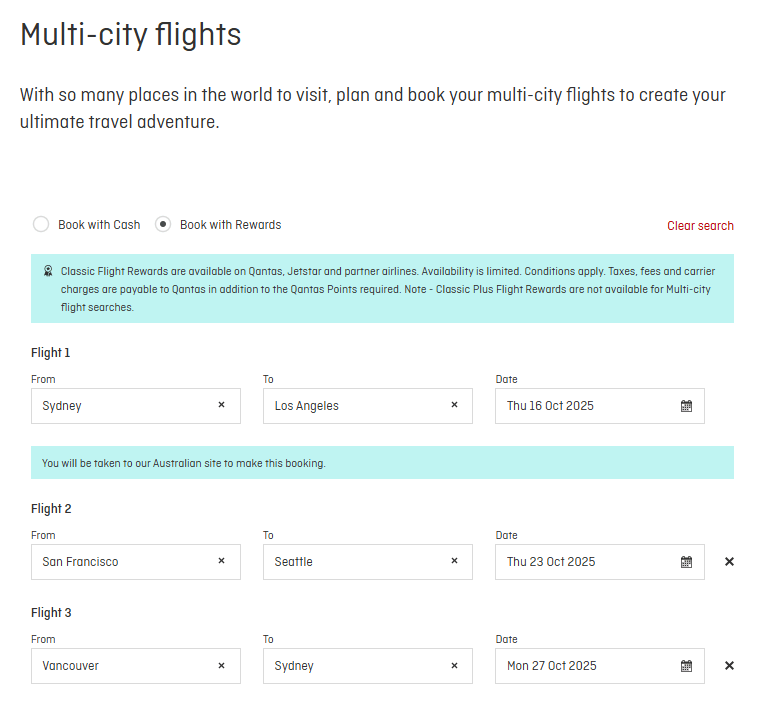
For this example, we selected the following nonstop flights incorporating travel on two Oneworld partners (American and Alaska) and Qantas.
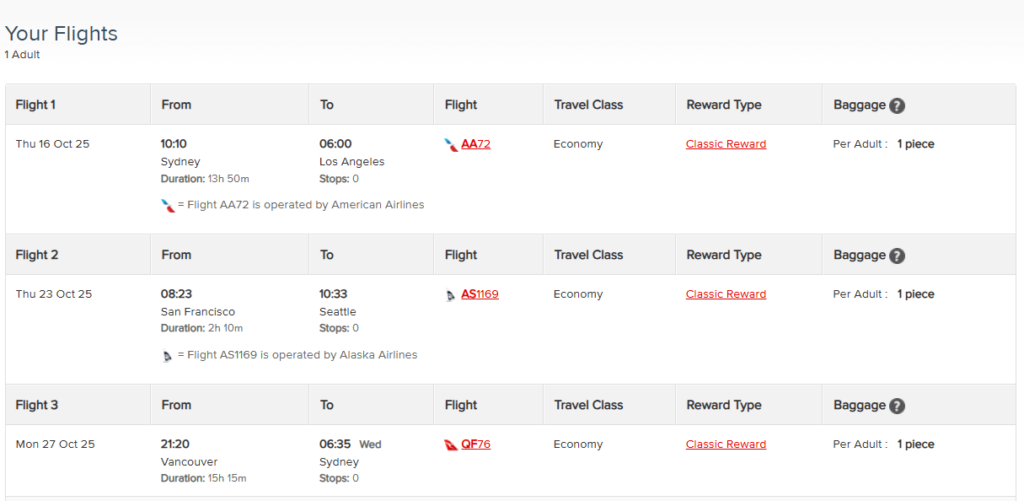
This itinerary includes two open-jaw (or surface) segments for portions of the trip where travelers might drive: between Los Angeles and San Francisco and between Seattle and Vancouver. The total flight distance (per Great Circle Mapper) is 16,388 miles including surface segments and 15,924 miles excluding surface segments.
During this search, we encountered issues with online functionality and couldn’t see the final award rate and fees. The account used didn’t have enough points to book an award, so that message was displayed. Other reports also indicate issues with booking these awards online.
Final Thoughts
It’s important to understand different booking options and recognize situations where open-jaw scenarios exist.
When considering whether to book outbound and inbound flights as separate one-way bookings or as round-trip or multi-city itineraries, some key considerations are:
- Relative benefit of having more flexibility to change flights in one direction without impacting the other direction vs. having all flights connected to minimize change and cancellation fees
- Availability of free or discounted one-way flights with multi-city bookings
- Whether you’re booking flights close to travel dates, when travel dates first become available for booking or sometime between those extremes
- Whether outbound and inbound flights are on the same airline, partner airlines that can be booked together or airlines that can’t be booked on a single ticket
- Rate differences for booking separate one-way tickets vs. booking a single ticket containing round-trip or open-jaw flights
- Information technology and program limitations for multi-city bookings

